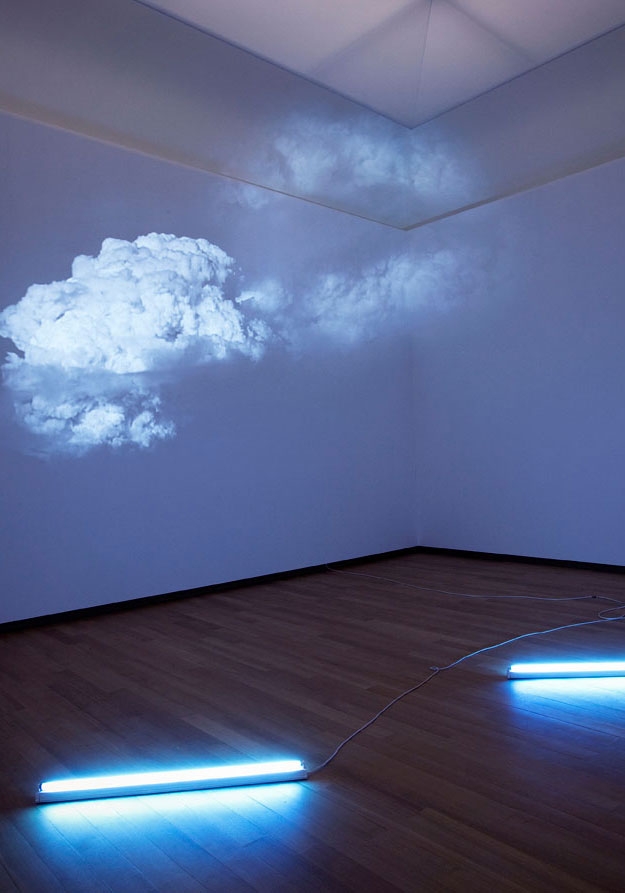Various venues, Lyon, 20 September 2017 – 7 January 2018
The invitation to curate the Lyon Biennale is something of an assignment: its artistic director (and cofounder, in 1991) Thierry Raspail proposes a ‘keyword’ (such as ‘global’, or ‘history’) that spans three editions and which curators are asked to interpret. Floating Worlds is Centre Pompidou-Metz’s Emma Lavigne’s take on the loaded – to the point of being hackneyed – word ‘modern’, spread across the contemporary art museum (MAC, of which Raspail is director), a former sugar factory (La Sucrière) and a Buckminster Fuller geodesic dome assembled on a city square for this edition. And modern it is, in a quite literal sense, with key early-twentieth century works being displayed alongside contemporary works throughout the MAC. Ernesto Neto’s signature light-and-textile environment Minimal Surface of a Body Evolution on a Field 2007) enshrines biomorphic, cloudy sculptures by Hans Arp and slashed paintings by Lucio Fontana; Cerith Wyn Evans’s mobile A=P=P=A=R=I=T=I=O=N (2008) interacts with spatial experiments by Zero group members Heinz Mack, Otto Piene and Fontana; Yuko Mohri’s Moré Moré (Leaky) The Falling Water Given #4-6 (2017) – in which three large three-dimensional wooden frames contain an elaborate mix of everyday objects connected by a circuit of plastic tubes through which water circulates, evoking the leaks that infiltrate subway stations in present-day Tokyo – is presented alongside a series of Marcel Duchamp’s box-works displaying miniature versions of his own work, notably a late edition of his Boîte-en-valise (1966).
modern it is, in a quite literal sense, with key early-twentieth century works being displayed alongside contemporary works
A consistent thread throughout the exhibition is the place given to music and sound works, and their crosspollination with poetry and visual arts. Lavigne cites Umberto Eco’s notion of the ‘open work’ – the work of art as a fertile ground for multiple interpretations – as well as the avant-garde plea for the hybridisation of fields. In one room, scores by concrete and minimalist musicians Terry Riley and Philip Corner dialogue with a maplike poem-composition by Fluxus artist Mieko Shiomi, while an elliptic story of an encounter by Ján Mančuška, displayed as lines of letters extended at eyelevel, traverses the space (Oedipus, 2006). At best, these free associations offer poetic encounters that resonate aesthetically, tracing filiations across art history; at worst, they feel merely superficial, resting on purely formal considerations. As a whole, the operation feels a bit traditional, with overtones of an outdated museum display.
The display at the Sucrière, however, is on the whole more contemporary, with works dating from the 1960s onwards. Everything here is in flux – from David Medalla’s cylinders slowly secreting wormlike formations of foam (Cloud Canyons, 1963–2016) on one side of the ground-floor space, to Damián Ortega’s suspended submarine made from industrial sacks and filled with salt, steadily pouring out its content through a punched hole (Hollow/Stuffed: market law, 2012), on the other. Somewhere in the middle, two of Hans Haacke’s ‘natural systems’ – Wide White Flow (1967–2017), a large silk sheet undulating to the airflow of fans and Together (1969–2017), a network of plastic tubes through which water and air are pumped alternately – circulate in the space.
Environmental issues arise through Bruce Conner’s Crosswords (1976), an assemblage of video footage of nuclear explosions mushrooming almost grandiosely to music by Riley. The work is echoed elsewhere on the wall by Diana Thater’s White is the colour (2002), a nebulous, foreboding black-and-white projection of a cloud that seems almost holographic (fluorescent tubes installed on the floor act to blur the edges of the frame); it hovers, in similar fashion to Conner’s film, halfway between sublime and destructive.
But the best work here is probably 67–76 (2017), a ten-minute film by Julien Discrit that revolves around the inauguration of another Buckminster Fuller dome: the geodesic, celestial one presented at the 1967 World Expo in Montreal, and the 1976 fire which destroyed the building’s acrylic bubble, leaving the steel structure bare. Healthy ‘modern’ young people are seen practising various sports – one surfs on the river, a group practices rowing – with the dome in the background; a deep soothing voice reads from Fuller’s seminal Operating Manual for Spaceship Earth, written that same year, in which he presented some of his visionary ideas on the environment, renewable energies and egalitarian society. As the characters all stop to watch the dome slowly burn into flames (recreated digitally by the artist), Discrit points to a bygone time of grand hopes for the future, offering gloomy resonances with the ecological crisis we are facing today.
More work like Discrit’s is maybe what’s lacking in this biennale. Lavigne conjures the idea of ‘liquid modernity’, a concept developed by philosopher Zygmunt Bauman to define the impermanent nature of the postmodern world in constant mutation. Yet the most interesting part of Bauman’s thinking is his analysis of the destabilising social impact of a ‘liquid’, fragmented world on the notion of selfhood, and as a result, on society and its future. Here, however, despite their undeniable qualities, the works on display generally fail to speak to our modern-day selves and the world we inhabit, and as such the show feels safe. With works floating midair between ‘imagination, poetry and art’ – Lavigne’s words – we find ourselves in search for something more grounding.
From the December 2017 issue of ArtReview
